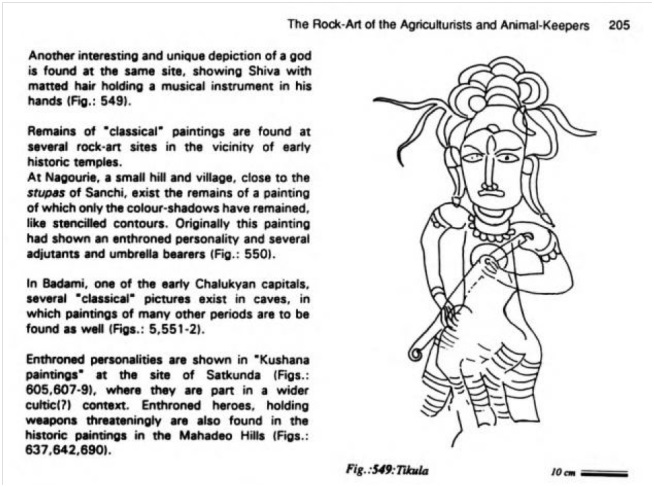Tikla, or Tikula, is an archeological site and ancient rock shelter in Madhya Pradesh, India, known for its petroglyphs. Tikla is situated around 170 km (110 mi) south of Mathura and 50 km (31 mi) southwest of Gwalior on the Agra to Mumbai road near the town of Mohana on the right bank of the Parvati river.
டிக்லா, அல்லது திக்குலா, இந்தியாவின் மத்திய பிரதேசத்தில் உள்ள ஒரு தொல்பொருள் தளம் மற்றும் பழங்கால பாறை தங்குமிடம் ஆகும், இது பெட்ரோகிளிஃப்களுக்கு பெயர் பெற்றது. டிக்லா மதுராவிற்கு தெற்கே 170 கிமீ (110 மைல்) தொலைவிலும், குவாலியருக்கு தென்மேற்கே 50 கிமீ (31 மைல்) தொலைவிலும் ஆக்ரா முதல் மும்பை சாலையில் பார்வதி ஆற்றின் வலது கரையில் மோகனா நகருக்கு அருகில் அமைந்துள்ளது.


Probably the earliest known Indian depiction of the Mathuran known as the Vrishni heroes, is a rock painting found at Tikla. This rock painting is dated to the 3rd-2nd century BCE, based on the paleography of the Brahmi inscription accompanying it. The deities are depicted wearing a dhoti with a peculiar headdress, and are shown holding their attributes: a plow and a sort of mace for Balarama, and a mace and a wheel for Vāsudeva. A third smaller character is added, forming what can be called a Vrishni trio, in the person of a female, thought to be the Goddess Ekanamsha, who seems to hold a Chatra royal umbrella. These depictions belong to "Period IV" of the rock shelter, and are accompanied by contemporaneous images of elephant riders, horse riders and flowers.
Tikla has a famous carved petroglyph representing a maze. It is the earliest known maze design in India, is dated to 250 BCE, and it is thought that the design was introduced with the campaigns of Alexander the Great.
விருஷ்ணி ஹீரோக்கள் என்று அழைக்கப்படும் மதுரானின் ஆரம்பகால இந்திய சித்தரிப்பு டிக்லாவில் காணப்படும் பாறை ஓவியமாகும். இந்த பாறை ஓவியம் கிமு 3-2 ஆம் நூற்றாண்டைச் சேர்ந்தது, அதனுடன் உள்ள பிராமி கல்வெட்டின் பழங்கால வரைபடத்தின் அடிப்படையில். தெய்வங்கள் ஒரு விசித்திரமான தலைக்கவசத்துடன் ஒரு வேட்டியை அணிந்தபடி சித்தரிக்கப்படுகின்றன, மேலும் பலராமருக்கு ஒரு கலப்பை மற்றும் ஒரு வகையான தந்திரம், மற்றும் வாசுதேவருக்கு ஒரு தந்திரம் மற்றும் சக்கரம் ஆகியவற்றைப் பிடித்தபடி காட்டப்பட்டுள்ளது. மூன்றாவதாக ஒரு சிறிய பாத்திரம் சேர்க்கப்பட்டுள்ளது, இது விருஷ்ணி மூவர் என்று அழைக்கப்படுவதை உருவாக்குகிறது, ஒரு பெண்ணின் உருவத்தில், சத்ர அரச குடையைப் பிடித்திருப்பது போல் இருக்கும் ஏகனாம்ஷா தேவியாகக் கருதப்படுகிறது. இந்த சித்தரிப்புகள் பாறை தங்குமிடத்தின் "காலம் IV" க்கு சொந்தமானது, மேலும் யானை சவாரி, குதிரை சவாரி மற்றும் பூக்களின் சமகால படங்கள் உள்ளன.
டிக்லாவில் ஒரு பிரமையைக் குறிக்கும் புகழ்பெற்ற செதுக்கப்பட்ட கல்வெட்டு உள்ளது. இது இந்தியாவில் அறியப்பட்ட முதல் பிரமை வடிவமைப்பு ஆகும், இது கிமு 250 இல் தேதியிடப்பட்டது, மேலும் இந்த வடிவமைப்பு அலெக்சாண்டர் தி கிரேட் பிரச்சாரங்களுடன் அறிமுகப்படுத்தப்பட்டது என்று கருதப்படுகிறது.
.jpg)

Vrishni triad shown in a rock painting at Tikla, Madhya Pradesh, 3rd-2nd century BCE. These would be Balarama, Vāsudeva and the female deity Ekanamsha. The inscription in Brahmi reads: Dambukena kāritam odanakita, probably conveying a contribution by someone named Dambuka
கிமு 3-2 ஆம் நூற்றாண்டு, மத்தியப் பிரதேசத்தின் டிக்லாவில் பாறை ஓவியத்தில் காட்டப்பட்டுள்ள விருஷ்ணி முக்கோணம். இவர்கள் பலராமர், வாசுதேவர் மற்றும் பெண் தெய்வம் ஏகநாம்ஷா. பிராமியில் உள்ள கல்வெட்டு பின்வருமாறு கூறுகிறது: தம்புகென கரிதம் ஒடனாகிட, தம்புகா என்ற பெயருடைய ஒருவரின் பங்களிப்பாக இருக்கலாம்.



.jpg)





No comments:
Post a Comment